Powdered drywall mud, also called “setting mud” or “hot mud,” contains chemicals that react when water is added to hasten hardening time. Compared to all-purpose premixed mud, this kind of mud tends to shrink less, but it hardens much more quickly.
Continue reading, and I’ll give you more details about hot drywall mud.
What Is Hot Drywall Mud?
The common name for setting-type drywall joint compounds is “hot mud.” They are available in powder form, and you must combine them with water to achieve the desired consistency. Instead of drying out like drywall mud, hot mud sets up like cement. Silverset 20 by Beadex is the product that I typically use. The “20” indicates that it can be worked for roughly 20 minutes before it begins to set up. You might need more than 20 minutes if you have a lot of work to do. There are various setting times available for the Silverset line of joint compounds. If you believe you will need a little more time, you can purchase Silverset 40, which gives you 40 minutes to work before it begins to set up. These setup times are estimates, so they could begin setting up a little earlier or they could take a little longer. Use of warm water will hasten their establishment as well.
Hot Drywall Mud Types
Here are the details:
Rapid-setting Or “Hot Mud”
The powdered version of quick-setting drywall compound is typically packaged in paper bags lined with plastic. The freshness is maintained and moisture is kept out by the plastic lining. Dryness is essential for the powdered mud. Mud hardens when water comes into contact with it while it’s still hot, starting an irreversible chemical reaction.
It is impossible to reuse quick-setting drywall compound once it has dried. Even a few tiny pieces of hardened mud can make the entire bag of hot mud useless. Hot mud chunks that have hardened cause drywall seams to scratch and make it very challenging to achieve truly smooth finishes.
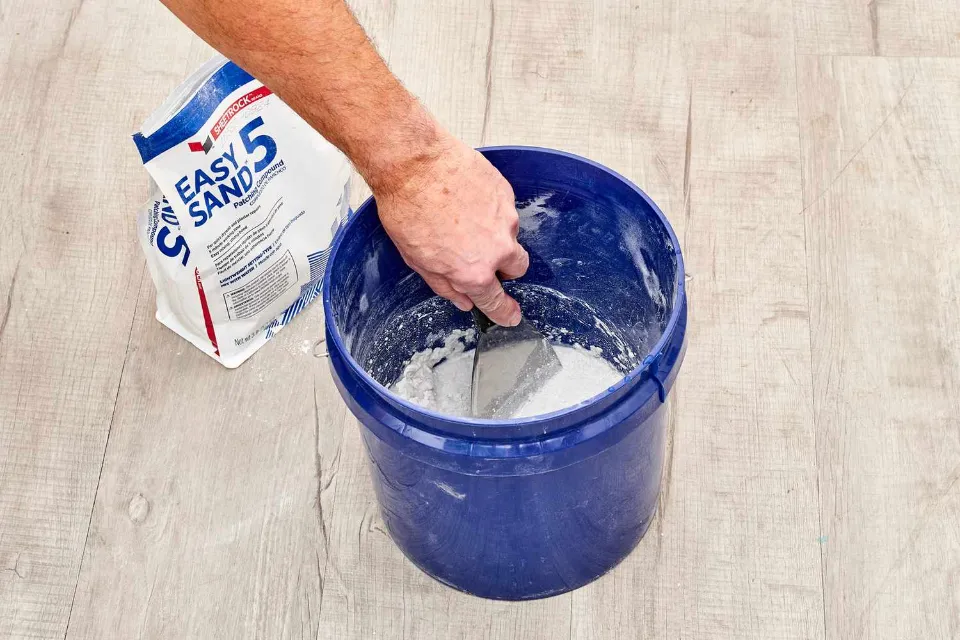
Pre-mixed Drywall Mud
Pre-mixed drywall mud is the other major type of drywall compound. When most people talk about drywall mud, they picture this.
Both 4.5 gallon buckets and boxes (cartons) containing a plastic bag of pre-mixed drywall mud are available for purchase. The mud boxes are typically 4.5 gallons in volume, though occasionally you’ll see 3.5 gallon boxes. So be sure to check the volume if you see a box of drywall compound that seems to be less expensive than most. As the name implies, pre-mixed drywall mud is already prepared for use.
Before use, pre-mixed drywall mud is almost always diluted with water. How the mud will be applied determines how much water is used. For instance, bedding in tape calls for a consistency that is thinner than usual.
In order for the drywall mud pump to operate smoothly, thin consistency is also required when using automatic taping tools. If it is too thin, however, it will be challenging to spread and will contract, leaving voids. Mud is the thinnest of all textures. Understanding what type of mud should be used for each application takes practice and time.
Different varieties of pre-mixed mud may be visible when looking for drywall mud. All-purpose, lightweight all-purpose, and topping are the three most frequently used. These are the most popular types of joint compound, though there are certainly many others.
What Is Mudding?
For a nice, flat surface to paint later, mudding entails applying thin coats of a specialized compound over the drywall joints, smoothing it out with a scraper, and making sure that all cracks and crevices are covered. You may have to apply several coats of drywall mud, depending on the condition of the wall.
The compound you’ll use usually has a paste-like texture and is white rather than brown like typical mud. Once you apply it, it needs time to dry and cure, and then it will need to be sanded smooth before you can proceed to the next step.
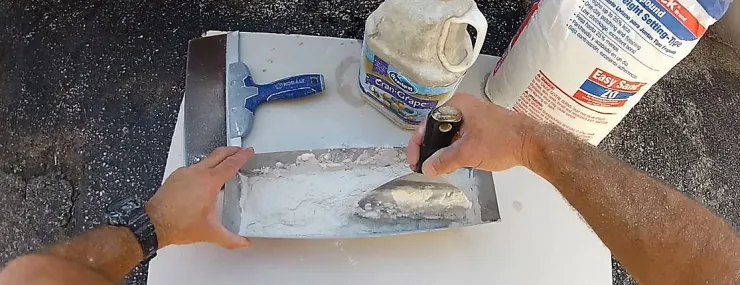
Why Pick Products For Hot Mud Drywall?
You can buy pre-mixed drywall compound, but some contractors and homeowners prefer to mix the compound themselves so they can obtain the consistency they want. Additionally, hot mud is frequently less expensive because the buyer bears the cost of the labor.
Once mixed, hot mud drywall products have a limited shelf life before becoming inoperable, much like cement. However, the hot mud drywall compound gives you a tough bond and sturdy result.
In addition, these compounds often dry faster than the pre-mixed versions. A hot mud drywall compound might be the best option for you if you prefer not to spend hours waiting to begin the next stage of your project.
How To Use Hot Drywall Mud?
Make sure you have all of your tools with you: paddles, knives, buckets, trays, hot mud drywall mix, a face mask or filter, and a power mixer to stir the compound. Follow the directions on the package carefully, just like you would with any chemical product, and abide by any usage guidelines that may be provided. You should begin by filling your mixture bucket with water; if you put the powder in first, the texture of your hot mud won’t be right.
If your compound looks too soupy, add more powder. If it’s too thick, add a bit of water. To achieve the ideal consistency—a thick but workable paste that resembles cake frosting—it may take a few attempts. Always mix a little more compound than you expect to need, so you don’t have to stop in the middle of the job to mix up more.
Keep in mind that hot mud doesn’t always provide the smoothest finish. You might get a surface that is bumpy or grainy if the consistency is off. Sand the flaws out or apply a final coat of ready-mixed all-purpose mud to seal everything up.
If you’re nervous about using hot mud drywall compound the first time, choose a single wall or a small section of the room, rather than attempting an entire room in one sitting. You’ll feel more at ease hot mudding the other parts of your space that require attention once you’ve experimented with the compound.
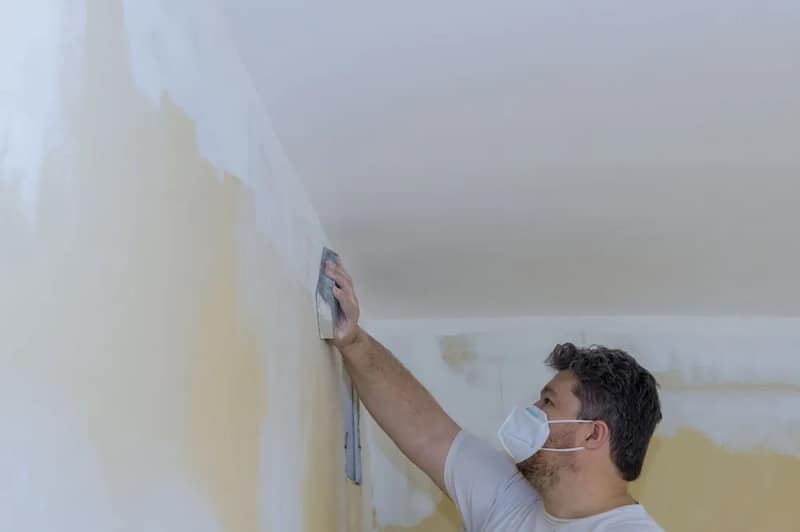
How To Mud Drywall?
It’s time to become familiar with the procedure described here after having a solid understanding of the mudding materials. We’ll go over paper tape mudging techniques because they produce the most professional results. The following advice will help you use mesh tape correctly if you’re using it.
Avoid Getting Drywall Mud On The Floor Or On You
Put on goggles and old clothes, then cover the floor with a canvas drop cloth (plastic drop cloths can become extremely slippery). Mudding is a messy process, and splatters can hurt your eyes if they get in them.
Mix Powdered Setting Mud If You Aren’t Using Premixed Mud
The mud bucket with the pre-mixed lid off should be done. If using powdered setting mud, combine as directed by the manufacturer, beating with a powerful drill equipped with a paddle bit until smooth.
The Factory Beveled Joints And Screw Indentations Should Receive The First Coat Of Mud
On both of their long sides, drywall panels are delivered with a slight bevel. When the bevels are assembled, they create a small indentation along the joints that is about 2 inches wide. With the 6-inch taping knife, fill the entire indentation with mud and remove any extra by working it smoothly and evenly into the joint.
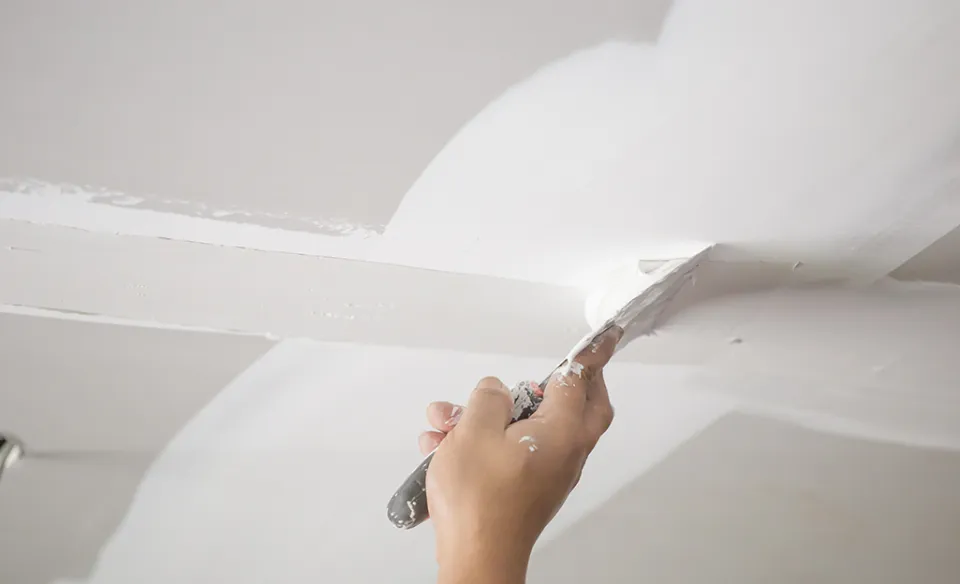
Put Some Tape Over The Mudded Joint
Cut and fit a piece of paper tape over the joint while the mud is still wet for a process called “bedding.” Smooth the paper onto the wet mud using the 6-inch taping knife, working out any air bubbles as you go. Use the knife to scrape off any extra mud.
Tape The Interior Corners
Apply a light layer of mud with the 6-inch knife, working it all the way into the center, to the inside corners on both sides. A pre-creased paper tape strip should be cut, folded, and fitted over the wet mud in the corner. Using a 6-inch taping knife or an inside-corner taping tool with a preformed 90-degree shape for simple bedding, gently smooth the paper tape in the wet mud. To bed the tape without knocking it out of the corner, use delicate stroking motions. Remove any extra mud from the walls.
Mud The Exterior Corners
If using preformed tape corners, adhere them as directed by the manufacturer. Then, use long vertical strokes on both sides to smooth mud over the corners to create a sharp, even corner.
Mud Butt Joints Last, If Necessary
By using sheets of drywall that cover the entire room, you can prevent butt joints, which happen when un-tapered ends of a drywall panel are fitted together. It is harder to achieve a smooth finish when working with ends that don’t have beveled indentations, though. Use as little mud as necessary to fill the joint and bed the tape when mudding them as you would the beveled joints.
Put On A Second Layer Of Mud
Before putting on the next coat, allow the mud to completely dry. In the same order as the first coat, apply a second coat of mud to the screw indentations, beveled joints, and inside and outside corners. This time, however, use only mud. No more tape is required! Simply spread a thin layer of mud and remove any extra with a cloth.
To The Butt Joints As Well, Add Another Layer Of Mud
To do a second coat for butt joints, take the 10-inch taping knife, apply two swaths of mud, approximately 8 inches wide, along both sides of the first joint coat, but not on top of the original joint. In order to hide a bulky butt-joint seam, the wall depth is gradually increased over a larger area. For a smooth appearance, use the knife to properly feather out the swaths’ edges.
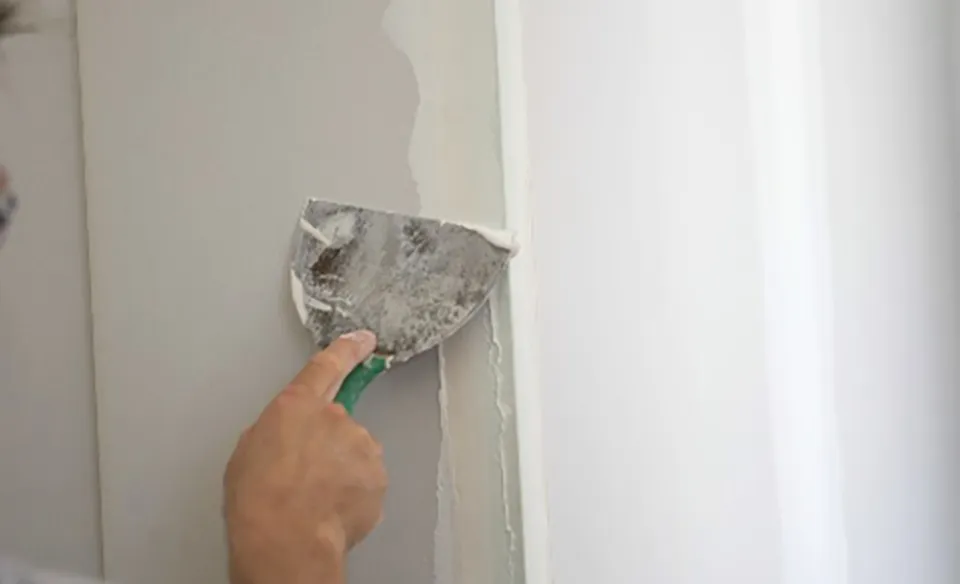
Add One Final Layer Of Mud
After the second coat has dried, add a third, extremely thin coat of mud. For all screw dents, seams, and corners, use the 10-inch knife. You can thin the mud’s edges to a razor-thin application by feathering them out with the wider knife. For previously beveled joints and corners, follow the same steps. On butt joints, apply a thin coat of mud over the previous swaths and the original mud joint. Mud swaths on butt joints frequently measure two feet in width or more.
Apply The Same Technique To Any Butt Joints
Apply a final thin coat over the butt joints only after the mud has dried. Allow the mud to dry while carefully feathering the edges.
At The Joints And Divots, Sand The Dried Mud
Prior to sanding, put on your respirator mask and safety glasses. Use a drywall pole sander or, if it’s crucial to limit airborne dust, rent a power drywall sander from your neighborhood construction rental shop. Till the wall is perfectly smooth, sand all joints and nail dents. You are now prepared to paint or wallpaper!
How to Mud Drywall With Mesh Tape?
Self-adhesive mesh tape is placed over seams and then mud is applied; unlike paper tape, which needs to be bedding in wet mud, mud seeps through the mesh into the seam beneath. Indentations for screws and beveled joints should be taped first, followed by inside and outside corners, and butt joints should be taped last. Corners should not be covered with mesh tape if you’re using it on flat joints. For inside corners, use pre-creased paper tape, and for outside corners, use pre-formed tape.
Hiring a Contractor
Get a contractor to handle your drywall mud project for you if you want the best results. It can be trying to make mistakes and have them show up. A contractor can complete the job quickly and seamlessly, giving your wall a flawless appearance.
While trying to do things on your own can be entertaining, if you’re concerned that they won’t turn out well, hire a professional. If you ask them, they might be able to teach you how to do it yourself. You’ll then be prepared for the next time!
Learning the fundamentals is essential right now. The different kinds of drywall mud, tape, and methods you can employ to complete the task come first.
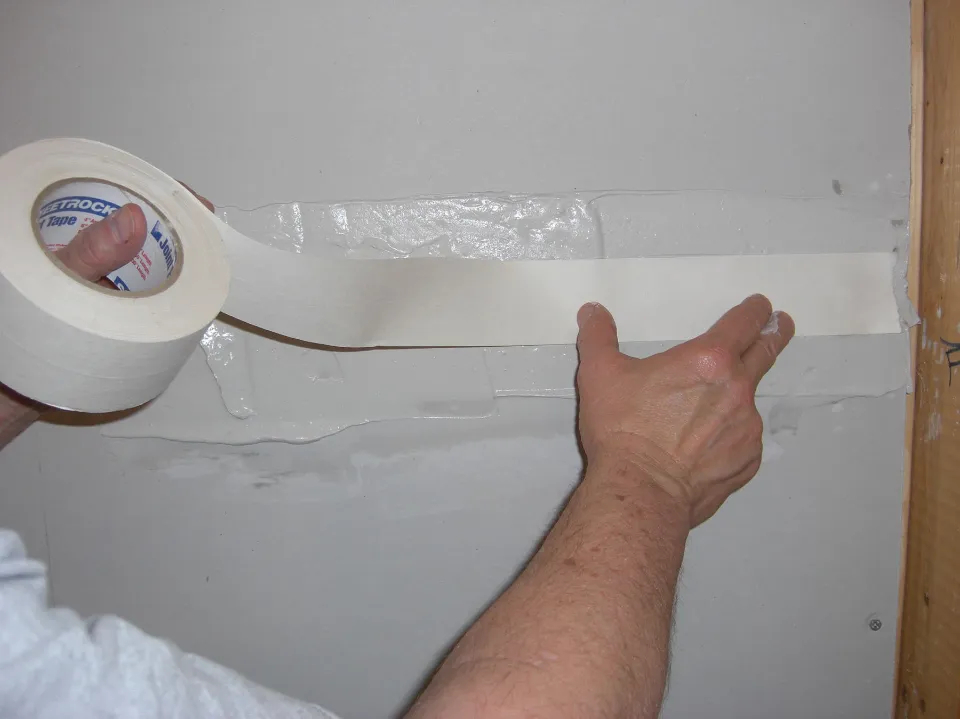
FAQs
Hot Mud Vs Joint Compound
Quick-setting joint compound, which is commonly referred to as hot mud, is a powdered product you mix with water to create the compound. Because hardening agents are added to the powder, this compound sets up more quickly than other types of drywall mud. This is what distinguishes it from other drywall mud types.
Hot Mud Joint Compound
Commonly called “hot mud,” quick-setting compound is ideal when you need to finish a job quickly or when you want to apply multiple coats on the same day. Sometimes called simply “setting compound,” this form is also useful for filling deep cracks and holes in drywall and plaster, where drying time can become an issue.
Are There Different Types of Drywall Mud?
The choices of mud come in either “dry” or “wet” varieties. In plastic-lined bags, dry mud is the powdered, quickly-setting form of mud. Mud that has been ground into a powder needs to be mixed using specialized equipment. This timed drywall mud dries slowly between coats and hardens quickly.
Is Hot Mud the Same as Plaster?
This joint compound is sometimes also referred to as drywall mud by the professionals. Plaster, on the other hand, is created from lime or a mix of gypsum powder, sand, and water. This combination creates a fairly thick paste, unlike joint compound.
Conclusion: What Is Hot Drywall Mud?
The topic of the article was hot drywall mud.
“Mudding, or the process of applying several thin coats of drywall compound to the joints and screw indentations in freshly hung drywall, sounds messy—and it is. But when done correctly, the result is a wall that is so smooth that few people can see the seams underneath.
Professional drywall tapers make the job appear simple, but do-it-yourselfers discover that it requires practice, skill, and, of course, the right tools for the job (in this case, the mud itself and the tape that prevents cracks from forming in the seams).
If you have any questions, please leave a comment. Don’t forget to share the post. I would like to thank you once more for reading.



